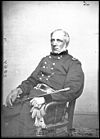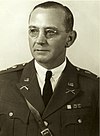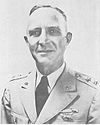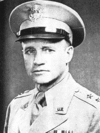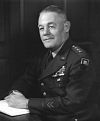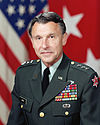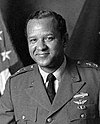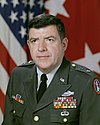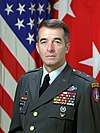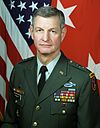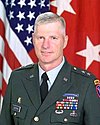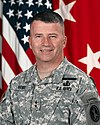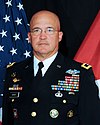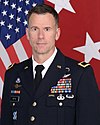United States Army Military District of Washington
| United States Army Military District of Washington | |
|---|---|
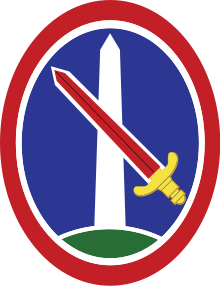 United States Army Military District of Washington shoulder sleeve insignia | |
| Active | March 12, 1862–1869; 1921-present |
| Country | |
| Allegiance | Regular Army |
| Branch | |
| Type | Army Command |
| Part of | JFHQ-NCR |
| Garrison/HQ | Fort Lesley J. McNair, Washington, D.C. |
| Nickname(s) | Guardian of the Nation's Capital |
| Motto(s) | Haec Protegimus ("This We Guard") |
| Website | Official Website |
| Commanders | |
| Current commander | Major General Allan M. Pepin |
| Notable commanders | Harry H. Bandholtz John T. Cole |
| Insignia | |
| Distinctive unit insignia | 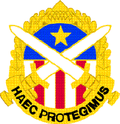 |

The United States Army Military District of Washington (MDW) is one of nineteen major commands of the United States Army. Its headquarters are located at Fort Lesley J. McNair in Washington, D.C. The missions of the units in the Military District of Washington include ceremonial tasks as well as a combat role in the defense of the National Capital Region.
Besides Fort McNair, the following installations are included under the umbrella of the MDW's command:
- Joint Base Myer–Henderson Hall, Virginia
- Fort Belvoir, Virginia
- Fort A.P. Hill, Virginia
- Fort Meade, Maryland
The Military District of Washington also represents the U.S. Army in the Joint Force Headquarters National Capital Region (JFHQ-NCR), as well as oversight of all ceremonial operations in Arlington National Cemetery.
The current Commanding General of the Military District of Washington is Major General Allan M. Pepin. The Military District of Washington Chief of Staff, and liaison to the JFHQ-NCR, is Colonel Gregory B. Beaudoin. The Commanding General, Chief of Staff, and Command Sergeant Major of the Military District of Washington hold the same positions at the JFHQ-NCR, which supervises military planning for the defense of the National Capital Region.
History[]
The MDW can trace its origin back to the American Civil War when it was formed on March 12, 1862, as the Military District of Washington, and it included the areas of the District of Columbia, Alexandria, Virginia, and Fort Washington, Maryland. It was first under the command of Bvt. Major General James S. Wadsworth.[1] It became part of the Department of Washington under the 22nd Army Corps on February 2, 1863 and it was disbanded in 1869.
The MDW was reformed in 1921 when the War Department created the District of Washington. Today MDW is one of the Army's major commands. Its installations include Fort McNair, the nation's second-oldest military post still in use, and Fort Myer, Gen. Philip Sheridan's cavalry showplace and site of the first military aircraft flight.
The District of Washington initially included Fort Washington, Md., Fort Hunt, Va., the District of Columbia and Fort Myer. With the dissolution of the District of Washington in 1927, the commanding general of the at Fort Hunt became responsible for conducting military ceremonies and administering discipline to service members in the nation's capital.
In 1942, about five months after the U.S. entered World War II, the War Department created the U.S. Army Military District of Washington to plan for a ground defense of the nation's capital.
MDW was headquartered during those years in "temporary" buildings at Gravelly Point, Virginia., near Washington National Airport. It moved to Second Street, S.W., in Washington, D.C., in the early 1960s, and to its present headquarters at Fort Lesley J. McNair in 1966.
During the World War II era, MDW was gradually reorganized as a service-and-support command. One of MDW's main responsibilities was servicing the newly built Pentagon through the Army Headquarters commandant. The United States Army Band, "Pershing's Own," also became an integral part of the command's ceremonial mission during this period.
At the end of World War II, the 3rd U.S. Infantry Regiment (The Old Guard) was deactivated in Germany. This regiment, the oldest U.S. infantry unit, was reactivated in 1948 and assigned to MDW to meet the command's tactical commitments and for military ceremonies.
Although MDW's mission has remained the same, it has gained, lost and regained various installations and support responsibilities over the years. Vint Hill Farms and Arlington Hall Station, both in Virginia, and Walter Reed Army Medical Center in Washington, D.C., were once part of MDW. Cameron Station and Davison Army Airfield, near Fort Belvoir, joined MDW in the 1950s.
In 1980 MDW gained responsibility for the administration and daily operation of Arlington National Cemetery, in addition to the ceremonial support the command has always provided.
In 1987 MDW's support responsibilities for the Pentagon were transferred elsewhere. Fort Belvoir became a major subordinate command in 1988.
In 1992 Davison Aviation Command was reorganized as the Operational Support Airlift Command, with responsibilities for fixed-wing Army aircraft support throughout the United States. Additionally, they provide rotary-wing (helicopter) support to Army leadership and distinguished officials in the National Capital Region.
In April 1993, MDW reorganized its MACOM staff and the Fort Myer Military Community formed a garrison staff to support Forts Myer and McNair, and Cameron Station.
On 1 October 1993, Fort Meade, and Fort Ritchie in Maryland, and A.P. Hill in Virginia joined the MDW family of installations. The command more than doubled in size as MDW went from four posts totaling 9,802 acres (39.67 km2) to eight posts totaling 91,889 acres (371.86 km2). The number of service members and civilians on MDW installations also increased from 16,166 to 61,531.
Cameron Station officially closed on 30 September 1995. Most of the organizations were relocated to either Fort Belvoir or Fort Myer.
Fort Hamilton, New York, became the newest member of MDW's family of installations when it was transferred to MDW from U.S. Army Forces Command 6 October 1997. The post is 172 years old.
On 10 June 2010, Secretary of the Army John M. McHugh rescinded MDW's responsibility for the administration and daily operation of Arlington National Cemetery. However, MDW still maintains ceremonial support for funerals and guarding the Tomb of the Unknown Soldier.
Ceremonial duties[]
Since its inception in 1942, the Military District of Washington has been involved in protecting and staging special event ceremonies. These ceremonies include inauguration ceremonies starting with Franklin Roosevelt's 4th inauguration on 20 January 1945. the MDW is also responsible for . They include anyone within Washington who is granted a state funeral. This includes former Presidents, Senators, Representatives, and other dignitaries. The MDW is extensively involved in the planning of and execution of a state funeral including advice and consent from the family and ceremonial support outside of Washington. The latter included a state funeral held for Richard Nixon held in the shadow of his boyhood home when he died following a stroke in April 1994.
Organization[]
Current units commanded by the district include;[2]
- The United States Army Band "Pershing's Own"
- The United States Army Field Band
- Regimental Headquarters and Headquarters Company, 3rd U.S. Infantry Regiment (The Old Guard)
- Caisson Platoon
- Commander-in-Chief's Guard
- Continental Color Guard
- The Old Guard Fife and Drum Corps
- Presidential Salute Battery
- Tomb of the Unknown Soldier Sentinals
- The United States Army Drill Team
- 1st Battalion, 3rd U.S. Infantry Regiment (The Old Guard) (Infantry)
- Headquarters and Headquarters Company, 1st Battalion
- B Company
- C Company
- D Company
- H Company
- 1st Battalion Chaplains Group
- 4th Battalion, 3rd U.S. Infantry Regiment (The Old Guard) (Ceremonial)
- Headquarters and Headquarters Company, 4th Battalion
- 529th Regimental Support Company
- A Company
- Honor Guard Company
- 289th Military Police Company
- Regimental Fife and Drum Corps
- United States Army Transportation Agency
-
- United States Army Priority Air Transportation (Jet) Detachment
- 12th Aviation Battalion
- Army Aviation Brigade Airfield Division
Insignia[]
Shoulder sleeve insignia[]
- Description: On a blue oval 2 7/8 inches in height fimbriated white within a 3/16-inch red border, issuing from a green mount in base fimbriated argent, the Washington Monument of the last superimposed by a red double-handed sword bendwise, fimbriated white, hilt and pommel yellow; all fimbriations 1/32-inch.
- Symbolism:
- The functions of the organization are indicated by the double-handed sword, symbolic of protection, over the Washington Monument, representing the area concerned.
- The blue represents the Navy and the Infantry; the scarlet the Field Artillery, Coast Artillery and Engineers, and the green and gold the Military Police.
- Background:
- The shoulder sleeve insignia was originally approved for Military District of Washington on 1942-09-26
- Redesignated for US Army Military District of Washington on 1971-07-21.
Distinctive unit insignia[]
- Description: A gold color metal and enamel device 1 3/16 inches in height overall consisting of an oval its upper half blue and containing a gold star in the center, the lower half divided into seven stripes alternately white and red. Bordering the bottom of the oval, a semicircular gold scroll inscribed with the words HAEC PROTEGIMUS in black, the scroll ends folded twice and forked with the points up below a border of gold oak leaves terminating at either side of a gold acorn with point up at top center, crossed in front two swords their gold hilts emerging from the folds of the scroll and their white blades terminating outside the oak leaf border.
- Symbolism:
- The background of the National colors refers to the seat of the government, which lies within the Military District of Washington, with the dome-shaped upper part suggesting the Capitol building.
- The Command's responsibilities of conducting ceremonies for the President of the United States and foreign dignitaries, Medal of Honor presentations, military funerals and guarding the Tomb of the Unknown Soldier are represented by the gold star.
- The oak leaves symbolize strength and courage and the crossed swords indicate the command's mission to defend the Nation's Capital.
- The motto translates to "This We Guard."
- Background:
- The distinctive unit insignia was originally approved for Headquarters, Military District of Washington on 1968-09-06;
- Revised to delete Headquarters from the designation on 1968-10-28;
- Redesignated for US Army Military District of Washington on 1971-07-21.
List of commanders[]
This list is incomplete; you can help by . (July 2021) |
| No. | Commander | Term | |||
|---|---|---|---|---|---|
| Portrait | Name | Took office | Left office | Term length | |
| - | Brigadier General James S. Wadsworth | 17 March 1862 | 7 September 1862 | 174 days | |
| - | Major General Harry Hill Bandholtz | 1921 | 1923 | ~2 years, 0 days | |
| - | Major General Charles F. Thompson | September 1944 | July 1945 | ~303 days | |
| - | Major General Robert Nicholas Young | July 1945 | 1946 | ~184 days | |
| - | Major General Hobart R. Gay | 1947 | September 1949 | ~2 years, 243 days | |
| - | Major General Thomas W. Herren | September 1949 | 8 March 1952 | ~2 years, 182 days | |
| - | Major General Edwin K. Wright | 8 March 1952 | 1954 | ~2 years, 0 days | |
| - | Major General | 1959 | 1961 | ~2 years, 0 days | |
| - | Major General Frederic E. Davison | November 1973 | 1974 | ~1 year, 0 days | |
| - | Major General Robert G. Yerks | 1 August 1975 | 15 July 1977 | 1 year, 348 days | |
| - | Major General Robert Arter | 1979 | 1981 | ~2 years, 0 days | |
| - | Major General | 1981 | 1983 | ~2 years, 0 days | |
| - | Major General John L. Ballantyne III | 1983 | 1986 | ~3 years, 0 days | |
| - | Major General | 1986 | 1990 | ~4 years, 0 days | |
| - | Major General William F. Streeter | 1990 | 20 May 1993 | ~3 years, 0 days | |
| - | Major General Fred A. Gorden | 20 May 1993 | 29 August 1995 | 2 years, 101 days | |
| - | Major General Robert F. Foley | 29 August 1995 | August 1998 | ~2 years, 349 days | |
| - | Major General Robert R. Ivany | August 1998 | 28 July 2000 | ~1 year, 350 days | |
| - | Major General | 28 July 2000 | 2003 | ~3 years, 0 days | |
| - | Major General Galen B. Jackman | 2003 | 21 July 2005 | ~2 years, 0 days | |
| - | Major General Guy C. Swan III | 21 July 2005 | 5 June 2007 | 1 year, 319 days | |
| - | Major General | 5 June 2007 | 23 June 2009 | 2 years, 18 days | |
| - | Major General | 23 June 2009 | 3 June 2011 | 1 year, 345 days | |
| - | Major General Michael Linnington | 3 June 2011 | 24 June 2013 | 2 years, 21 days | |
| - | Major General Jeffrey S. Buchanan | 24 June 2013 | 9 June 2015 | 1 year, 350 days | |
| - | Major General Bradley Becker | 9 June 2015 | 28 April 2017 | 1 year, 323 days | |
| - | Major General Michael L. Howard | 28 April 2017 | 4 June 2019 | 2 years, 37 days | |
| - | Major General | 4 June 2019 | 8 June 2021 | 2 years, 4 days | |
| - | Major General | 8 June 2021 | Incumbent | 87 days | |
See also[]
References[]
- Eicher, John H., and David J. Eicher. Civil War High Commands. Stanford, CA: Stanford University Press, 2001. ISBN 0-8047-3641-3.
- ^ Eicher, p. 547
- ^ "The U.S. Army Military District of Washington". Retrieved 22 November 2019.
External links[]
- United States Army Direct Reporting Units
- Military in Washington, D.C.
- Departments and districts of the United States Army

